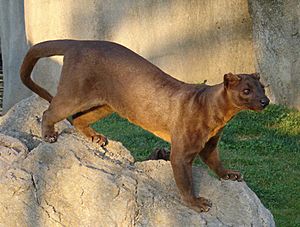Fossa facts for kids
Have you ever heard the word fossa? It's a fun word that can mean many different things! Depending on where you are or what you're talking about, it could be a unique animal, a beautiful waterfall, a place on a map, or even a person's last name.
This page will help you explore all the cool meanings of "fossa."
Amazing Animals
- The fossa is a super cool meat-eating mammal that lives only on the island of Madagascar. It looks a bit like a small cougar but is related to the mongoose family.
- Fossa is also the scientific genus name for the Malagasy civet. This animal is a smaller relative of the fossa and also lives in Madagascar.
Places in Nature
- Fossá is a stunning waterfall in the Faroe Islands. It's one of the tallest in the country and cascades down a cliff in two sections.
- Fossa (river) is the name of several different rivers in Iceland.
People Named Fossa
"Fossa" or "Fossas" can also be a last name. Here are some people who have it:
- Bernardino of Fossa (1420–1503), an Italian writer and historian from a long time ago.
- François de Fossa (1775–1849), a French musician who played the classical guitar and wrote music for it.
- José Fossa (1902–1967), a soccer player from Argentina.
- La Fossa, a rap music group from Italy.
- Tony Fossas (born 1957), a professional baseball player from Cuba.
Towns and Villages
You can find places on the map named Fossa:
- Fossa, Abruzzo, a town in the country of Italy.
- Fossa, County Kerry, a village in Ireland.
- Fossá, Faroe Islands, a village in the Faroe Islands that is no longer lived in.
- Fossa Beg and Fossa More are two areas in Ireland called "townlands." A townland is a small, local land division.
Other Cool Meanings
The word "fossa" has a few other interesting uses:
- In science, a fossa is a shallow dent or hollow area, like the ones you can find on bones.
- In astronomy, a fossa is a long, narrow ditch or trench on the surface of a planet or moon.
- In ancient Rome, a "fossa" was a ditch or a moat, which is a deep ditch often filled with water that was dug around a castle for protection.
- Formaggio di fossa is a special type of cheese from Italy. Its name means "pit cheese" because it is left to age in special underground pits!
See also
 In Spanish: Fossa para niños
In Spanish: Fossa para niños

All content from Kiddle encyclopedia articles (including the article images and facts) can be freely used under Attribution-ShareAlike license, unless stated otherwise. Cite this article:
Fossa Facts for Kids. Kiddle Encyclopedia.

